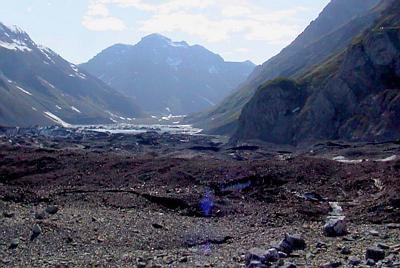10 July, 2000
July 10, 2000
I awoke at 4:00 AM to a driving rain pattering loudly against the roof of my
tent. It was a cold rain - the type that sinks to your bones. As I looked
out my tent and saw the clouds wrapping around the lower margins of the
surrounding peaks, I concluded that there was no way that a helicopter would
come out in this weather to move us to our new drill site and camp. As it
turns out, PSU grad student Don Lindsay, St. Olaf undergraduate Andrew Malm,
and PI Andrew Fountain had reached similar conclusions. At 7:00 AM Andrew
Fountain decided to make a call to the helicopter company - Era, which is
based in Valdez. We had all made the wrong conclusion. The helicopter was
on its way. We had to hurry a bit. But we were ready when it arrived.
Our new camp and drill site is situated about 0.5 km from the drainage outlet
of the Hidden Creek Lake Basin. It is on the main stem of the Kennicott
Glacier. Our camp is on a thick pile of rocks - mostly large boulders. This
type of feature on a glacier is called a moraine. Because it makes a
longitudinal stripe down the glacier, it is called a medial moraine. These
rocks came from some valley wall located far up the glacier. We have about a
200-meter walk to the drill site, which is located on some white ice near a
turquoise green pool. Drilling should progress much more rapidly at this
location - the ice here does not appear to include as many rocks as our
former site.
U.S. Geological Survey scientist Dennis Trabant continues to survey his
reflectors on the ice dam every four hours. He has quite an eagle-eye view
of the rest of us. He looks down on us, and the lake team. He also has the
best vantage point to communicate with the stream team in McCarthy. So, in
terms of communication, he really is the point man. He was the communication
relay between PI Joe Walder at the lake, PI Andrew Fountain on the ice, and
the helicopter pilot during today's move.
The lake team is finished with their fieldwork. PI Joe Walder flew out
today. PSU grad student Michelle Cunico joined the glacier camp. There are
a number of instruments in the lake gathering data that is being stored on
data loggers. These will be retrieved after break out. Joe Walder has been
pretty frustrated that past few days. It appears that some of his
instruments have failed in the lake. One big success of the lake team is
that they were able to use a fish finder to characterize the bottom of the
lake all the way to the margin of the ice dam.
By the time we left our former drill site today a number of fresh crevasses
had begun to open - up to 6 inches in one case. We got some data from Dennis
Trabant this evening, which explains why. From his survey data he has
calculated that our former camp raised 10 cm (about 4 inches) from July 4 to
July 5. From the 5th to the 6th it raised 16 cm (7 inches). From the 6th to
the 7th the surface of our former camp elevated 26 cm (11 inches). From the
7th to the 8th - 53 cm. And from the 8th to the 9th, the former camp and
drill site raised 56 cm. In all, since we arrived at our first camp, it has
been raised by about 6 to 7 feet. In case you are wondering, this is the
result of lake water moving beneath and into the ice dam (where we were
camped), and floating it. This movement explains the ice deformation we were
observing and hearing around our work site.
It is much quieter here.
The lake continues to rise - we just watch and shake our heads in puzzlement,
wondering how the glacier can hold back the amount of hydraulic pressure that
so much water represents.

The view of Hidden Creek Lake from my tent at our new camp site. The survey location of Dennis Trabant is located in the upper right of the photo (yellow speck is his tent). Our former camp is in the extreme center left of the photo, in the area just below the large uplifted blocks of ice. Note that the lake is choked with icebergs, which made it challenging for Joe Walder and Michelle Cunico to work on the lake.

Contact the TEA in the field at
.
If you cannot connect through your browser, copy the
TEA's e-mail address in the "To:" line of
your favorite e-mail package.
|
